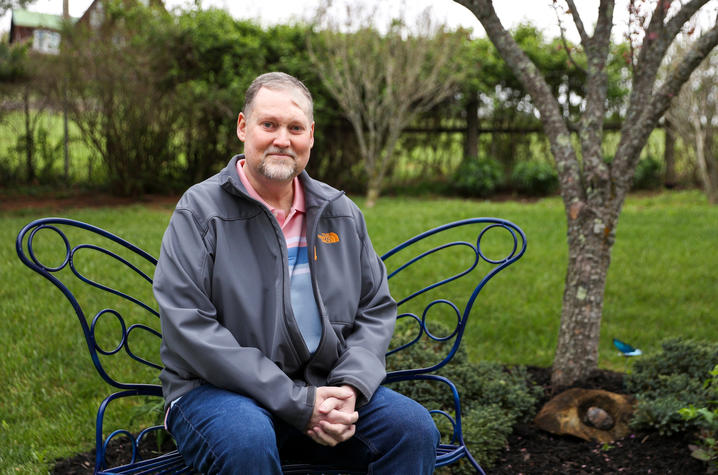
LEXINGTON, Ky. — After Rodney Tompkins experienced a sudden onset of debilitating headaches, a scan revealed he had a tumor the size of an egg in the frontal lobe of his brain and it could be cancer.
The 40-year-old Berea resident would need surgery to remove the mass from his brain and determine if it was cancerous. Rodney, a nurse at University of Kentucky Albert B. Chandler Hospital, knew the news could be grim. The average five-year survival rate for patients with a primary brain tumor is 35.7% – depending on the diagnosis, he could have months to live.
With the surgery scheduled in two months, Rodney decided to start making the most of the present. He was able to check the first item off his bucket list: taking his 3-year old granddaughter to Disney World.
“I just focused on making memories with my family and cherishing the time I had left,” Rodney said. “First thing was that I needed to see my granddaughter have breakfast with the princesses in Cinderella’s castle.”
After the surgery, Rodney’s worst fears were confirmed when pathology tests revealed he had an aggressive form of brain cancer. But more than a decade after his diagnosis and treatment at the UK Markey Cancer Center, Rodney is still cherishing every day. So far, the tumor that once threatened his life has not returned.
‘Your job is to get better’
Results showed Rodney had a grade 3 brain cancer called anaplastic astrocytoma. Typical survival for patients with this diagnosis is two to five years. Despite preparing himself for the worst, the diagnosis was devastating.
“It’s not what I wanted to hear. I was hoping they’d just take out the tumor and then I’d be on my way,” Rodney said.
From the very beginning of Rodney’s cancer journey, his wife, Tracy has been a motivating force.
“We had our breakdown,” she said. “But then I told Rod it was time to buck up. Your only job was to just focus on treatment and get better. We had our grandbaby that needed him here.”
Primary brain tumors are one of the most challenging cancer diagnoses for patients and their families, and a strong support system makes all the difference during treatment, says Rodney’s neuro-oncologist at Markey Cancer Center, John Villano, M.D., Ph.D.
“I could tell from the start that Mr. Tompkins had strong family support, which continued throughout his treatment,” Villano said. “It has undoubtedly played a role in his continued survival.”
Anaplastic astrocytomas belong to the broader brain tumor category of gliomas. Because advanced gliomas “infiltrate” the brain, surgery to remove the tumor is not usually enough to prevent it from coming back. Due to recurrence, Rodney underwent two additional resection surgeries by UK HealthCare and Kentucky Neuroscience Institute neurosurgeon Thomas Pittman, M.D.
Surgery was followed by radiation therapy and chemotherapy. Rodney was also among the early users of Optune, a wearable device that delivers low-intensity alternating electric fields to disrupt cancer cell growth.
The road wasn’t easy. In 2018, Rodney had an additional brain surgery, this time to address a sudden onset of seizures that were likely a side effect of radiation therapy. But over a decade since his diagnosis, the tumor hasn’t returned. Rodney gets an MRI every six months to check.
Villano says that while anaplastic astrocytoma is incurable, the good news is that the probability of survival increases each year after initial diagnosis and treatment.
Rodney says his motto is, “You have to live for today because nobody’s promised tomorrow.”
Now 51 years old, he has some memory impairment and knows there’s still a possibility of recurrence. But for him, each new day is a gift. He now has three granddaughters he can spoil at Disney.
Advancing brain cancer research
Longer-term survivors of anaplastic astrocytoma do exist, and researchers have learned that their tumors usually have molecular features that predict better outcomes.
In Rodney’s case, his astrocytoma had a mutation of a protein known as “IDH” – patients with an IDH mutation generally have better outcomes. In addition, the tumor lacked expression of an enzyme called “MGMT,” which helps repair cancer cells after they have been damaged by chemotherapy. The chemotherapy drug temozolomide is significantly more effective without the expression of MGMT.
Villano says that the past two decades have brought a rapid advancement in scientists’ understanding of the genetic drivers of brain tumors.
“When it comes to brain cancer treatment, we know that patients with primary brain tumors are living longer and doing better than before,” Villano said. “We think a lot of this has to do with and learning these prognostic factors, such as IDH, and other molecular mutations.”
Rodney’s unique case has contributed to the research, too.
In 2017, Villano and colleagues published a case study in the academic journal Cancer Chemotherapy and Pharmacology, which highlights Rodney’s successful long-term use of the chemotherapy drug temozolomide. The paper outlines a feasible and beneficial approach to treatment for patients with astrocytomas that share the same unique genetic features.
The advancement is tied to the emergence of precision medicine. Researchers analyze the molecular characteristics driving a patient’s tumor growth and find or develop drugs to target those abnormalities.
Clinical trials play a key role in bringing these treatments to patients. As the only NCI-designated cancer center in Kentucky, Markey offers patients unique access to some of the latest treatments for brain cancer through clinical trials. This includes the medication Vorasidenib, which is expected to be FDA-approved for treatment of diffuse gliomas and works to stop tumor growth in gliomas by targeting the IDH protein.
Rodney’s astrocytoma treatment has advanced cancer research, so that even more patients can have better outcomes. His cancer journey also gives hope to others facing the same diagnosis that survival can be possible.




























